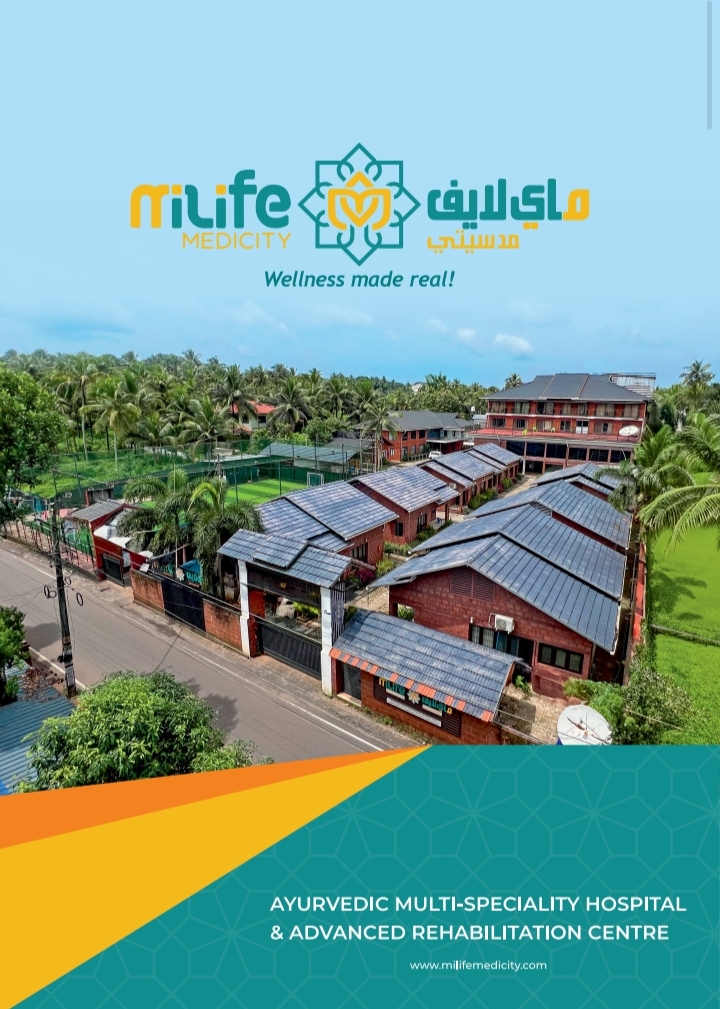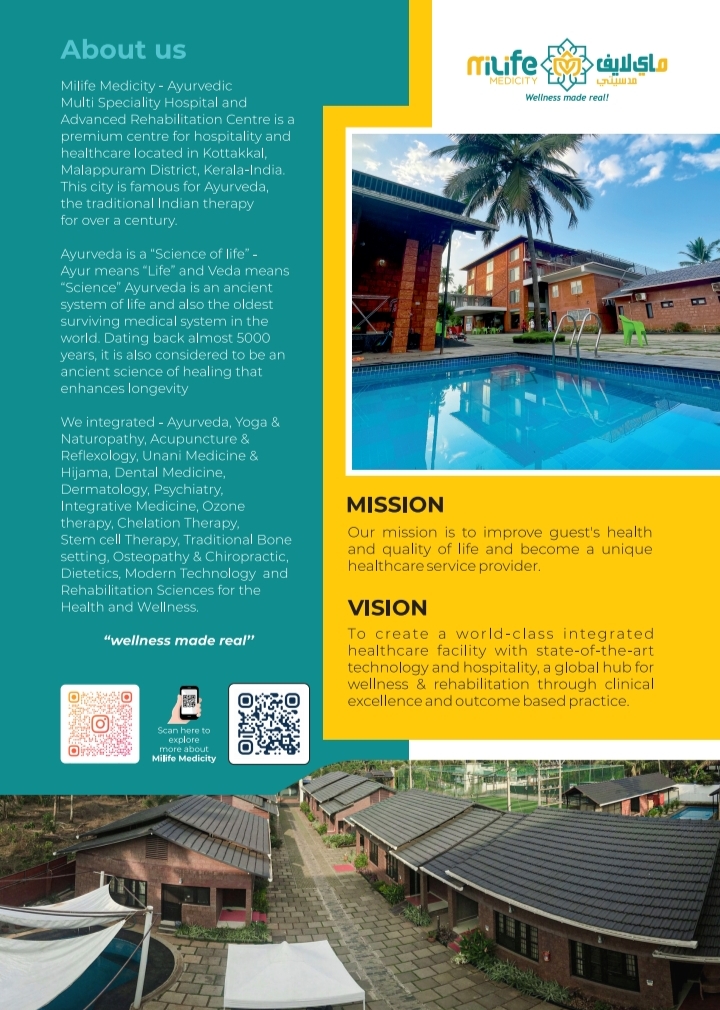Milife Medicity
Milife Medicity, Nayadipara Road, Near Football Turff, Kottakkal, Malappuram, 676510
Since : 2019
Milife Medicity, Nayadipara Road, Near Football Turff, Kottakkal, Malappuram, 676510
Since : 2019
Reflexology is a therapeutic practice that involves applying pressure to specific points on the feet, hands, and ears, which correspond to different organs and systems in the body. It is a holistic treatment that helps promote relaxation, reduce stress, improve circulation, and support the body's natural healing processes. Reflexology is based on the idea that these reflex points are connected to various parts of the body and that stimulating them can have a positive effect on overall health and wellness.
In Kottakkal, a town known for its strong heritage in Ayurveda and alternative medicine, reflexology treatment centres offer specialized services designed to provide relief from stress and promote healing. These centres combine traditional reflexology practices with modern wellness techniques, offering a comprehensive approach to holistic health.
· Milife Medicity
Nayadipara Road,
Near Football Turf,
Kottakkal,
Malappuram, 676510
· Arya Vaidya Sala
Main Road,
Kottakkal,
Malappuram, 676503
· Punarjani Ayurvedic Clinic
Near KSRTC Bus Stand,
Kottakkal,
Malappuram, 676503
· Sree Chaitanya Therapy Centre
Edarikode Road,
Kottakkal,
Malappuram, 676503
· Sree Subramanya Therapy Centre
Kizhakkethala,
Kottakkal,
Malappuram, 676503
· Vaidyaratnam Ayurvedic Therapy Centre
Puthur Road,
Kottakkal,
Malappuram, 676503
· Anandam Ayurvedic Centre
Changuvetty,
Kottakkal,
Malappuram, 676503
· Santhigiri Ayurveda & Siddha Vaidyasala
Edarikode,
Kottakkal,
Malappuram, 676501
· Sreepathi Ayurveda Therapy Centre
Athani Road,
Kottakkal,
Malappuram, 676503
· Dhanwanthari Therapy Centre
Perinthalmanna Road,
Kottakkal,
Malappuram, 676503
Reflexology is a therapeutic practice based on the idea that specific points
on the feet, hands, and ears correspond to different organs and systems in the
body. By applying pressure to these reflex points, reflexologists believe they
can stimulate the body's natural healing processes and promote overall
wellness. Reflexology is a holistic therapy that aims to balance the body’s
energy flow, reduce stress, improve circulation, and enhance relaxation.
Reflexology is an ancient practice with roots in Chinese and Egyptian
medicine. It is based on the concept that there are reflex points in the hands,
feet, and ears that are connected to specific parts of the body. By applying
pressure to these points, reflexologists aim to remove energy blockages,
stimulate nerve function, and improve circulation to encourage the body’s
natural healing processes.
The underlying principle is that the body is divided into zones, and every organ, muscle, and gland can be influenced by pressing on specific areas of the feet and hands. Reflexology is often used to manage stress, relieve pain, improve digestion, boost energy, and enhance overall well-being.
Reflexology works through the stimulation of reflex points, which are believed to correspond to different body parts and systems. By pressing, rubbing, or massaging these points, reflexologists help to unblock energy pathways and restore balance to the body's systems.
During a reflexology session, the practitioner may use their fingers, thumbs, or hands to apply pressure to certain points on your feet, hands, or ears. The pressure points are believed to send signals to the central nervous system, which then triggers a relaxation response, reduces stress, and improves the functioning of the corresponding body part.
Reflexology
is a holistic therapy that offers a wide range of physical, emotional, and
mental health benefits. By applying pressure to specific points on the feet,
hands, and ears, reflexology helps stimulate the body’s natural healing
processes and restore balance. Below are some of the key benefits of
reflexology treatment:
1. Stress Reduction and Relaxation
One of
the most significant benefits of reflexology is its ability to reduce stress
and promote relaxation. By stimulating reflex points, reflexology activates the
parasympathetic nervous system, which is responsible for calming the body and
mind. This helps lower stress hormone levels, leading to deep relaxation,
mental clarity, and a sense of well-being.
2. Improved Circulation
Reflexology
enhances blood circulation throughout the body, which helps deliver oxygen and
nutrients to cells more efficiently. Improved circulation supports the body’s
natural detoxification processes and promotes overall health.
3. Pain Relief
Reflexology
is commonly used to relieve pain associated with various conditions such as
arthritis, headaches, migraines, back pain, and menstrual discomfort. By
applying pressure to specific reflex points, reflexologists can help reduce the
intensity of pain signals sent to the brain.
4. Boosted Immune System
Regular
reflexology sessions can strengthen the immune system by promoting the elimination
of toxins and supporting the lymphatic system. The stimulation of reflex points
corresponding to the lymph nodes and immune organs can enhance the body's
defense mechanisms.
5. Enhanced Digestion
Reflexology
can help regulate digestive function by stimulating reflex points related to
the stomach, intestines, and other digestive organs. This can be particularly
beneficial for people suffering from digestive issues like constipation,
irritable bowel syndrome (IBS), and indigestion.
6. Hormonal Balance
Reflexology
is beneficial for balancing hormones, especially for women experiencing
menopause, menstrual irregularities, or fertility issues. By stimulating reflex
points related to the endocrine glands (such as the pituitary, thyroid, and
adrenal glands), reflexology can help regulate hormonal production and balance.
7. Mental Clarity and Emotional Well-Being
In
addition to its physical benefits, reflexology also promotes mental and
emotional well-being. Reflexology can help reduce anxiety, improve focus, and
enhance emotional resilience by calming the nervous system and releasing
built-up emotional tension.
8. Detoxification and Toxin Elimination
Reflexology
helps support the body’s natural detoxification processes by stimulating reflex
points connected to the liver, kidneys, and lymphatic system. These organs play
a crucial role in filtering and eliminating toxins from the body.
9. Enhanced Nerve Function
As we
age, nerve endings can become less sensitive, affecting communication between
the body and the brain. Reflexology stimulates more than 7,000 nerve endings in
the feet and hands, helping to improve neural pathways and nerve function.
10. Improved Sleep Quality
Reflexology
is well-known for promoting deep relaxation, which directly contributes to
better sleep quality. By reducing tension, balancing energy flow, and calming
the nervous system, reflexology can help individuals struggling with insomnia
or sleep disturbances.
Reflexology
is a holistic therapy designed to promote healing, relaxation, and balance
throughout the body by applying pressure to specific reflex points on the feet,
hands, and ears. If you’re new to reflexology or considering it for the first
time, here’s what you can expect from a typical treatment session:
1. Initial Consultation
Before
your reflexology treatment begins, the practitioner will conduct an initial
consultation to gather important information about your health, lifestyle, and
any specific concerns you have. This helps the reflexologist tailor the session
to meet your unique needs and ensure the therapy is safe and effective for you.
2. Relaxing Environment
Reflexology
sessions are usually conducted in a calm, relaxing environment to promote
relaxation and healing. The room may be dimly lit, and soft music or nature
sounds may play in the background. The reflexologist will ensure you are
comfortable, whether seated in a reclining chair or lying on a massage table.
3. Comfortable Positioning
During
the session, you’ll be asked to remove your shoes and socks (if the treatment
is focused on the feet) and get comfortable in a seated or reclined position.
The reflexologist may use pillows or blankets to ensure you are fully supported
and comfortable throughout the session.
4. Application of Pressure
The
reflexologist will begin by gently massaging your feet, hands, or ears to warm
up the area and prepare for the treatment. Once you are relaxed, the
practitioner will apply specific pressure to reflex points that correspond to
different organs, glands, and systems of the body. This pressure is applied
using the thumbs, fingers, or specialized tools.
5. Sensation During Treatment
During
the session, you may feel a range of sensations, including mild discomfort or
tenderness in certain reflex points. These sensations are usually brief and
indicate that the corresponding area of the body may be out of balance or
experiencing tension. Many people describe the overall experience as deeply
relaxing and enjoyable.
6. Post-Session Effects
After a
reflexology session, many people experience immediate relaxation and relief
from stress. Some may feel energized, while others feel a sense of calm and
balance. It’s common to feel lighter on your feet, with improved circulation
and reduced tension in the muscles.
7. Possible Detoxification Effects
Reflexology
can stimulate the body’s detoxification processes, encouraging the release of
toxins from the body. As a result, you may experience detox symptoms such as
increased urination, mild headaches, or fatigue after the treatment. These
symptoms are usually short-lived and are a sign that the body is eliminating
waste products and restoring balance.
8. Follow-Up Sessions
For best
results, reflexology is often recommended as a regular part of a wellness
routine. The frequency of treatments depends on your health needs, personal
goals, and the recommendations of your reflexologist. Some people choose to
have weekly sessions, while others may schedule treatments once or twice a
month.
9. Benefits Over Time
Reflexology
is a cumulative therapy, meaning that its benefits often build over time with
regular sessions. While some individuals may experience immediate relief from
pain or stress, others may notice gradual improvements in their overall health,
mood, and well-being after several treatments.
1. Is Reflexology the Same as a Massage?
No,
reflexology and massage are two different therapies. Reflexology focuses on
applying pressure to specific reflex points in the feet, hands, and ears, which
correspond to different parts of the body. Massage therapy, on the other hand,
involves the manipulation of muscles and tissues to relieve tension and improve
circulation. Reflexology is more targeted and is based on the concept of energy
pathways.
2. What Conditions Can Reflexology Help With?
Reflexology
is used to support a variety of health conditions, including:
3. Is Reflexology Safe?
Yes,
reflexology is generally safe for most people. However, it’s always important
to consult with a healthcare provider before starting reflexology, especially
if you are pregnant, have a medical condition, or are undergoing treatment for
a serious illness. Reflexology is a complementary therapy, not a replacement
for medical treatment.
4. How Many Reflexology Sessions Are Needed to See
Results?
The
number of reflexology sessions needed depends on the individual’s condition and
treatment goals. Some people may experience immediate relief after one session,
while others may require multiple sessions to notice improvements.
Reflexologists typically recommend a series of treatments for chronic or
long-term issues.
5. Can Reflexology Be Used Alongside Other
Treatments?
Yes,
reflexology is often used in combination with other therapies such as massage,
acupuncture, chiropractic care, and conventional medical treatments. It is
considered a complementary therapy and can enhance the effects of other
treatments. However, always consult with your healthcare provider before
combining therapies.
6. Is Reflexology Painful?
Reflexology
is generally not painful. Most people find it relaxing, although certain reflex
points may be more sensitive due to underlying health issues. Any discomfort is
usually brief and subsides as the therapy progresses. The therapist can adjust
the pressure based on your comfort level.
7. Can Reflexology Help with Stress and Anxiety?
Yes,
reflexology is widely used to reduce stress and anxiety. By stimulating reflex
points that correspond to the nervous system, reflexology promotes relaxation,
reduces tension, and helps calm the mind. Many people report feeling more
relaxed and centered after a reflexology session.
8. Is Reflexology Suitable for Children?
Yes, reflexology
can be beneficial for children as well. It is a gentle and non-invasive therapy
that can help with various conditions such as digestive issues, sleep
disturbances, and anxiety. Pediatric reflexology practitioners tailor the
sessions to suit the needs of children.

Malappuram, Kottakkal

Malappuram, Kottakkal